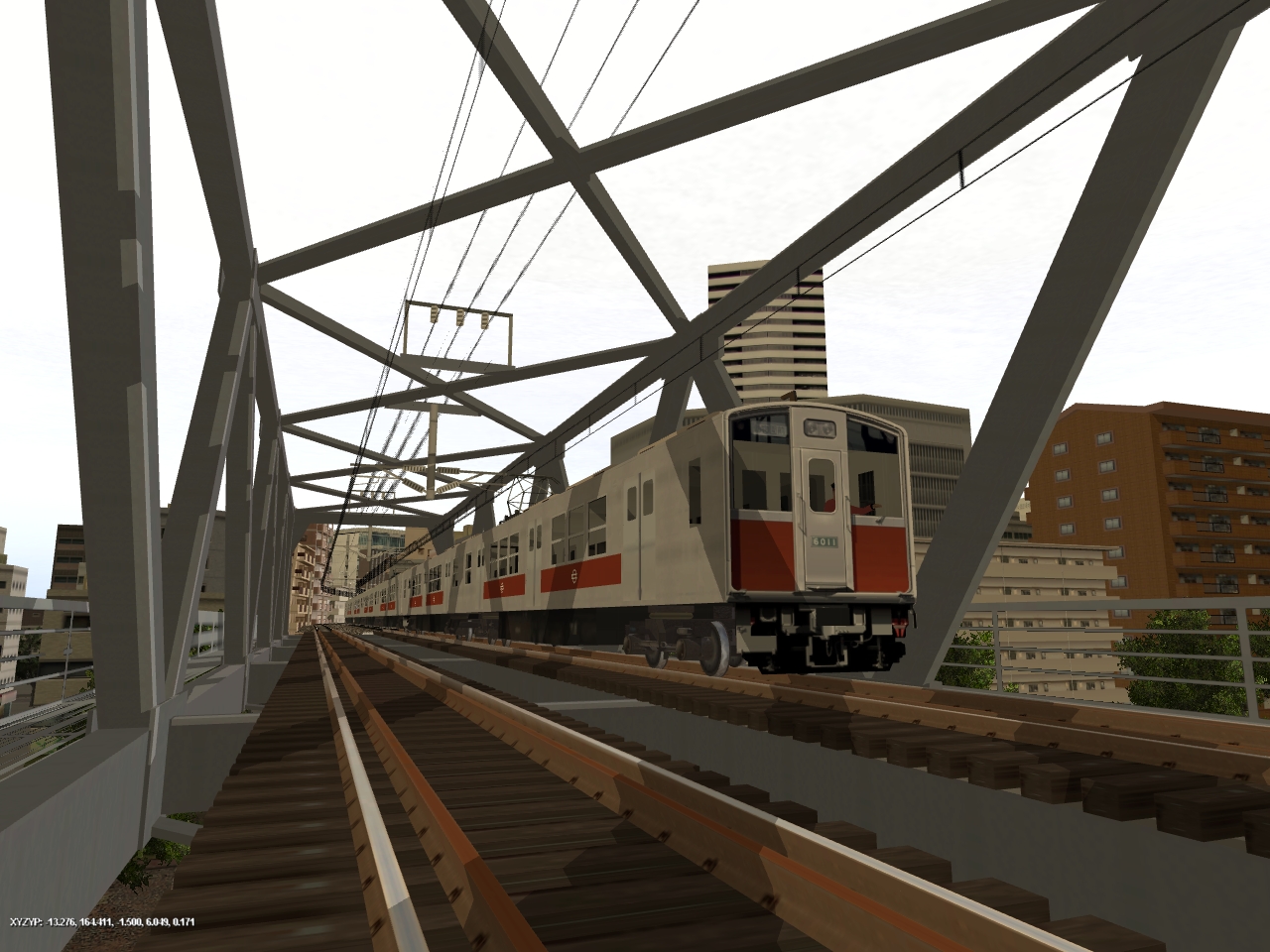
DOWNLOAD (update planned)
All the necessary dependencies are either included in this package or are avaible on the DLS.
The 60 series was introduced in 1969, with the opening of the first section (Tenjinbashi-Rokuchome to Dobutsuen-Mae) of the Sakaisuji Line (Line No.6) of the Osaka Municipal Subway, wich was to be an “urban penetration” extension of the Hankyu Senri Line, wich at the time served the Osaka Expo’70 grounds (with a temporary stop between Minami-Senri and Kita-Senri station) and also Senri New Town, thus inter-running services with Hankyu were planned from the start (up to Kita-Senri on the Senri Line and up to Takatsuki on the Hankyu Kyoto Line) therefore the Sakaisuji Line was to be a catenary-fed 1435mm-gauge line compatible with Hankyu’s trains.
The 60 series was based on the third-rail lines all-alluminium 30 series, wich were designed in 1967 and at the time were put in service as fast as possible to replace all the older rolling stock on the other lines (especially line No.1-Midosuji Line wich at the time had most of its trains dating from pre-war times, and it was to be the main railway line serving the Expo grounds), thus the 30 and 60 series were designed to be as easy and as fast to be built as possible, with all trains sharing the same unpainted stainless steel body, doors, control stands, seats and manufacture plates (in fact they all read “built in october” depsite most of the production taking place in november).
Depsite all the similarities, the 60 series also had distinctive fetaures: the top-mounted headlight, akin to all Hankyu trains at the time and the recessed driver windows (a fetaure that inspired the 9000 series of Odakyu railway).
Built in only two months, a total of 90 vehicles were made by four different manufacturers: Kawasaki Heavy Industries (formations 1-3), Nippon Sharyo (formations 4-8), Kisha Seizo (formations 9-14) and Hitachi (formations 15-18).
The 60 series entered service in 5-car sets, with unpainted alluminium bodies except for the lower part of the front units wich was painted bright red due to visibility concerns. Trains running special “Expo’70 Rapid” services had two circular headmarks on both sides of the front.
When the Expo ended, all the stainless Osaka subway rolling stock started recieving bodyside coloured lines indicating the line servded, to avoid mistaking trains.
The 60 series got red bodysides, wich lasted little as the Midosuji Line trains were also red, so by 1978, the 60 series color was changed from red to their distinctive reddish-brown wich they carried until their retirement. At the same time they were reformed in 6-car sets.
By the late 1980s, the rushed design and lack of passenger comfort (compared to the high-end Hankyu trains, wich all had air conditioning) of the 60 series became evident, so an alternative started taking form.
The 66 series was introduced in 1993 (and it’s still in service), and it was the exact opposite of the 60 series: comfortable, good-looking and air-conditioned from the start. It was built in 8-car sets, and it used GTO-VVVF inverters.
Also in 1993, the 60 series trains were reformed into 9 8-car sets (01, 02, 03, 04, 06, 07, 11, 12, 14), with air conditioners being retrofitted on formations 01, 02, 03, 11 and 12.
The remaining cars not inserted into an 8-car set were scrapped in 1993 along the whole formation No.5 wich was followed by formations 04, 06, 07 and 14 in 1994.
The remaining air-conditioned formations were retired by 2003, with the last run of a 60 series set on the 7th of November.
All the veichles were scrapped except unit 6014 wich was restored to it’s original 1969 style and is currently preserved at Morinomiya depot.
Trivia #1
While the Hankyu Lines are legally classified as railways, Osaka Subway lines are classified as tramways (in fact the full name for the Sakaisuji Line is
“Osaka City Rapid Electric Tramway Line No.6 – Sakaisuji Line”, thus Sakaisuji Line trains are the only ones in Japan that swich daily from a railway to a “tramway”.
(de-facto railway but de-jure tramway, this is rather a legal cavil as it does not concern technical matters and standard railway rules apply to all Osaka subway lines).
Trivia #2
Depsite being designed with a maximium speed of 100Km/h, the 60 series ran daily at 110Km/h on the Hankyu Kyoto Line without any trouble.
Trivia #3
In the summers months from the mid to late 1980s these trains (wich at the time still had no air-conditioning) became so uncomfortable, that passengers on both the Sakaisuji Subway Line and the overground Hankyu Lines would wait for an air-conditioned Hankyu train to come, rather than boarding a 60 series.
The consists avaible are:
– “time of debut”, 5-car set
– “time of debut with Expo’70 headmarks”, 5-car set
– “red body sides”, 5-car set
– “brown body sides”, 6-car set
– “brown body sides with AC” – 8-car set
Bonus Image:

1970, an original-styled 60 series running an “Expo’70 rapid” service (note the double headmarks), approaching the temporary station for the Expo (in the background), on a brand-new section of the Hankyu Senri Line.